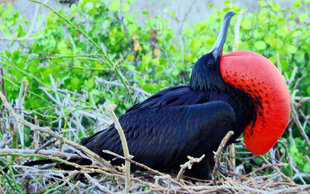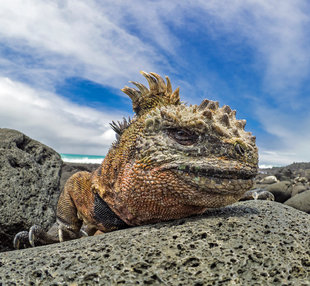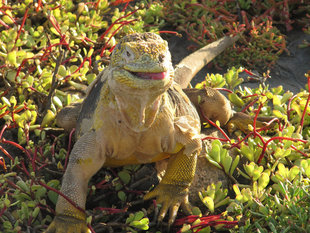Area Size: 10.4 Km²
Maximum Altitude: 62 feet
Island Highlights: Land Iguanas, Baltra Airport, Geological Features
Introduction
Baltra is located 27 km north of Santa Cruz Island and is the site of the islands' rather isolated main airport. Some visitors will be able to see their boat moored in Baltra Harbour nearby and will board by means of a short small boat ride. Others will need to travel to the far south of Santa Cruz Island to Puerto Ayora, which is the largest town in the Galapagos. This involves a bus ride across Baltra, then a ferry to Santa Cruz, and then by road again across Santa Cruz.
The island is fundamentally a start and finish point for many of our Galapagos voyages, as there are no real visitor sites or attractions, nor is there any visitor accommodation. The public and private transportation available on Baltra exists for the sole purpose of transferring visitors to the harbour or ferry to Santa Cruz Island.
Until 1986, Baltra was the location for the only airport in the Galapagos. The airport was originally built by the U.S. military in during World War II in 1941 as a base to protect the Panama Canal from enemy attack. The airport now shares flights with the airport on San Cristobal Island, but still receives the majority of flights from the mainland. In 2007, Baltra airport embarked on a modernisation project to provide additional eating options, a few shops and an overall improved visitor area. This project is currently still underway.
Today, Baltra continues to be an official Ecuadorian naval base, with remains of the US base still visible on the island. In 2009, Baltra officially became part of the Galapagos National Park and thus part of the National System of Protected Areas of Ecuador.
Wildlife
Baltra is an arid island with the most common plant life consisting of salt bushes, prickly pear cacti and palo santo trees.
Between 1932 and 1933, a decision was made to relocate 70 of Baltra'a land iguanas to the neighbouring island of North Seymour as part of an experiment. This decision proved to be very wise, as shortly after the military base was established Baltra land iguanas consequently became extinct on their native island. In the 1980s, a pair of North Seymour land iguanas was taken to the breeding centre in Santa Cruz, where they soon bred and numbers started to increase. In 1991 the land iguanas were reintroduced to Baltra. The numbers of land iguanas on Baltra has been carefully monitored over the years, with 420 of them reported to be living on Baltra in 2007. Due to the overall success of the breeding programme, the national park sees no further need to continue it and have decided to let nature take its own course. Land iguanas are now frequently seen in the areas surrounding Baltra airport.
Conservation Issues
Due to the negative effects that introduced species have had on the archipelago in the past, the Galapagos islands are now extremely vigilant over what comes in and what goes out. Upon arrival into Baltra airport, passengers are required to show their passports, INGALA Visitor Control Card and pay their Galapagos National Park fees. Passengers' bags are then thoroughly inspected to ensure that no foreign plants or animals have been imported.
Geology
Baltra is a relatively flat island, not dissimilar to the landscapes found on the neighboring island of North Seymour. The island is approximately 2 million years old and was originally formed by a geological uplift. The geological formations to be found on the island have varying origins, some comprising fresh lavas and spatter cones, while others consist of eroded tuff formations.
Flights
Baltra Island houses the main airport for the Galapagos islands, receiving the largest number of flights from the Ecuador mainland airports of Quito and Guayaquil. The main carrier serving the airport are TAME, LATAM and Aerogal (owned by Avianca). Small propellor plane flights are available to Puerto Villamil on Isabela Island and to Puerto Baquerizo Moreno on San Cristobal Island. These flights are operated by Emetebe.



